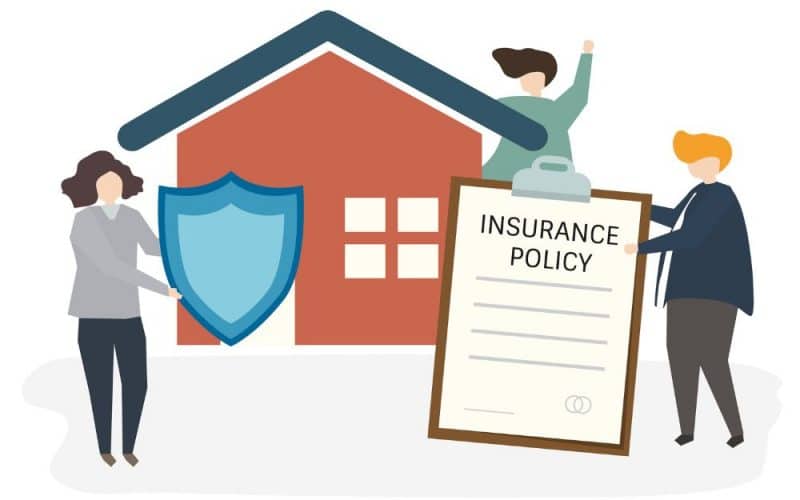A homeowners insurance policy provides you with financial protection in the event of a disaster or accident involving your home. A standard homeowners insurance policy insures your home’s structure (house,) and your belongings in the event of a destructive event, such as a fire.
In addition, homeowners insurance policies are generally “package policies.” This means that the coverage includes not only damage to your property but also your liability—that is, legal responsibility—for any injuries and property damage to others caused by you or members of your family (including your household pets).
All forms of home insurance also provide additional living expenses (ALE) coverage for the extra costs of living away from home if it is uninhabitable due to damage from an insured disaster.
Overview of homeowners insurance policy
Homeowners insurance is a form of property insurance that covers losses and damages to an individual’s residence, along with furnishings and other assets in the home. Homeowners insurance also provides liability coverage against accidents in the home or on the property.
A homeowners insurance policy usually covers four kinds of incidents on the insured property: interior damage, exterior damage, loss or damage of personal assets/belongings, and injury that occurs while on the property. When a claim is made on any of these incidents, the homeowner will be required to pay a deductible, which in effect is the out-of-pocket costs for the insured.
Every homeowners insurance policy has a liability limit, which determines the amount of coverage the insured has should an unfortunate incident occur. The standard limits are usually set at $100,000, but the policyholder can opt for a higher limit. If a claim is made, the liability limit stipulates the percentage of the coverage amount that would go toward replacing or repairing damage to the property structures, personal belongings, and costs to live somewhere else while the property is worked on.
Acts of war or acts of God such as earthquakes or floods are typically excluded from standard homeowners insurance policies. A homeowner who lives in an area prone to these natural disasters may need to get special coverage to insure their property from floods or earthquakes.
However, most basic homeowners insurance policies cover events like hurricanes and tornadoes.
Types of homeowners insurance policies
To better understand how the different types of home insurance work, it’s important to know how they’re set up. A “peril” is an incident or problem that causes damage to your home, yourself or your belongings. Generally, there are two ways coverage is explained in a policy—open peril and named peril:
- Named peril. All hazards that are covered by the policy are specifically listed, or named. Anything not listed is not covered.
- Open peril. Hazards that are not covered are listed in your policy as exclusions. Anything that’s not listed as an exclusion is covered.
Here’s a roundup of the eight different types of homeowners policies for homeowners.
HO-1 home insurance policy
Also known as basic form homeowners insurance, the HO-1 provides bare-bones coverage. An HO-1 policy will pay out only if one (or more) of 10 specific perils damages your home:
- Fire or lightning
- Windstorm or hail
- Explosion
- Riot or civil commotion
- Damage caused by aircraft
- Damage caused by vehicles (such as a car that crashes into your house)
- Smoke
- Vandalism or malicious mischief
- Theft
- Volcanic eruptions
An HO-1 policy is limited because it typically covers only these 10 perils instead of the 16 or more that other policies do. It generally provides coverage only for the house structure, at actual cash value. That means you won’t get the amount you’d need to fully rebuild, but rather the value of the house minus deprecation for its age. It generally doesn’t cover personal property, liability, or additional living expenses.
The HO-1 costs less than other types of coverage because it provides the least coverage. It is not available in most states and, if you have a mortgage, you usually are required by a lender to have higher levels of protection.
HO-2 home insurance policy
Also called the broad form, the HO-2 policy provides coverage for more perils than the HO-1 policy. The HO-2 policy covers all the perils in an HO-1 policy plus:
- Weight of snow and ice
- Accidental overflow or discharge of water or steam
- Freezing of plumbing, air conditioning
- Bulging or cracking caused by a sudden and accidental event
- Falling objects
- Sudden, accidental damage caused by artificially generated electrical current
An HO-2 policy includes:
- Dwelling coverage for your house and other structures on your property
- Coverage for your personal belongings
- Personal liability
- Loss of use or additional living expenses coverage
- Medical payments to others
Also, under an HO-2 your belongings are covered for actual cash value only, which is how much the items are worth after depreciation.
HO-3 home insurance policy
The HO-3 policy provides suitable coverage for most homeowners and is the most common home insurance policy type. It covers your house and belongings and includes coverage for liability, medical payments to others and additional living expenses.
An HO-3 policy, unlike the HO-1 and HO-2, protects your house from all perils unless they are specifically listed as exclusions. This is called an “open peril” policy. Also known as a special form, an HO-3 policy will pay to repair or replace your house, up to your policy limits, as long as the damage was not due to these typical exclusions:
- Power failure
- Industrial pollution or smoke
- Earthquake
- Flooding
- Intentional damage
- War/nuclear accidents
- Pets and insects
- Settling, wear and tear
- Negligence
- Government actions and legal action due to lack of permits, faulty construction, design, or maintenance actions taken by the government and other associations
- Damage or theft in unoccupied homes or those under construction
- Deterioration due to weather conditions, that aggravate other excluded causes
For your belongings such as electronics, furniture and clothing, an HO-3 policy provides coverage for 16 perils:
- Fire or lightning
- Windstorm or hail
- Explosion
- Riot or civil commotion
- Damage caused by aircraft
- Damage caused by vehicles
- Smoke
- Vandalism or malicious mischief
- Theft
- Volcanic eruption
- Falling object
- Weight of snow, ice, and sleet
- Accidental overflow of water from household appliances or heating, plumbing, air conditioning systems or sprinkler systems that put out fires
- Freezing of household appliances or heating, plumbing, air conditioning systems or sprinkler systems that put out fires
- Accidental cracking, burning, or tearing of heating, plumbing, air conditioning systems or sprinkler systems that put out fires
- Accidental damage due to short-circuiting of an electrical current
HO-4 home insurance policy
Known as renters insurance, the HO-4 policy is for people renting houses and apartments. Belongings are covered for the same 16 perils listed in the HO-3 policy. Additional living expenses and liability coverage are also included.
An HO-4 policy will not cover damage to the rental unit itself. A landlord would need their own landlord insurance policy to cover the structure.
HO-5 home insurance policy
Called a comprehensive policy, an HO-5 policy offers the highest level of insurance coverage for houses and belongings. It covers your house and belongings under all circumstances except those listed as exclusions in the policy. The exclusions for HO-5 policies are the same as those under an HO-3.
An HO-5 policy will pay out for replacement costs rather than actual cash value. An HO-5 also includes coverage for liability, medical payments to others and additional living expenses.
These comprehensive policies are often good for insuring new construction. Not all home insurance companies offer HO-5 policies.
HO-6 home insurance policy
The HO-6 policy is for people who live in a condo or a co-op. Known as “walls-in coverage,” a condo insurance policy covers:
- Any renovations you made to the condo after you bought it
- Walls, floors and ceilings
- Personal belongings
- Additional living expenses
- Liability
- Medical payments to others
Before buying an HO-6 policy, it’s a good idea to review your condo association’s insurance policy. You want to avoid gaps in coverage and also sidestep any duplicate offerings with the association’s insurance.
HO-7 home insurance policy
The HO-7 policy has similar coverage to an HO-3 policy but it applies to mobile homes. Mobile home insurance is an open peril policy for the structure of the mobile home or trailer. Like the HO-3, that means it covers any damage as long as it is an exclusion. Coverage for belongings is only for specific perils listed in the insurance policy, like to HO-3.
HO-7 policies insure these types of structures:
- Single and double-wide manufactured homes
- Single and double-wide mobile homes
- Trailers
- Sectional homes
- Modular homes
An HO-7 policy typically only covers a mobile home when it is stationary. It does not provide coverage when the home is in transit.
HO-8 home insurance policy
HO-8 home insurance policies are generally for older homes usually built more than 40 years ago. For these houses, the cost of rebuilding is usually greater than the home’s market value. Historic homes and registered landmarks usually have HO-8 policies. An HO-8 policy only covers your house and belongings for 10 specific perils listed in the policy:
- Fire or lightning
- Windstorm or hail
- Explosion
- Riot or civil commotion
- Aircraft
- Vehicles
- Smoke
- Vandalism or malicious mischief
- Theft
- Volcanic eruption
Coverage for liability, medical payments to others and additional living expenses is also included under an HO-8.
Homeowners insurance policy and mortgages
When applying for a mortgage, the homeowner usually is required to provide proof of insurance on the property before the financial institution will loan any funds. The property insurance can be acquired separately or by the lending bank. Homeowners who prefer to get their own insurance policy can compare multiple offers and pick the plan that works best for their needs.
If the homeowner does not have their property covered from loss or damages, the bank may obtain one for them at an extra cost.
Payments made toward a homeowners insurance policy are usually included in the monthly payments of the homeowner’s mortgage. The lending bank that receives the payment allocates the portion for insurance coverage to an escrow account. Once the insurance bill comes due, the amount owed is settled from this escrow account.
Homeowners insurance vs. mortgage insurance
A homeowners insurance policy also differs from mortgage insurance. Mortgage insurance is typically required by the bank or mortgage company for homebuyers making a down payment of less than 20% of the cost of the property. The Federal Home Administration also requires it of those taking out an FHA loan.1 It’s an extra fee that can be figured into the regular mortgage payments, or be a lump sum charged when the mortgage is issued.
Mortgage insurance covers the lender for taking on the extra risk of a home buyer who doesn’t meet the usual mortgage requirements. If the buyer should default on payments, the mortgage insurance would compensate. While both deal with residences, homeowners insurance protects the homeowner, and mortgage insurance protects the mortgage lender.
Homeowners insurance vs. home warranty
While the terms sound similar, homeowners insurance is different from a home warranty. A home warranty is a contract taken out that provides for repairs or replacements of home systems and appliances such as ovens, water heaters, washers/dryers, and pools. These contracts usually expire after a certain time, usually 12 months, and are not mandatory for a homeowner to buy in order to qualify for a mortgage.
A home warranty covers issues and problems that result from poor maintenance or inevitable wear-and-tear on items—situations in which homeowners insurance doesn’t apply.
Recommended Articles
- Home Inspector Insurance: Coverage, Cost & Best Options
- Hazard Insurance vs. Homeowners Insurance: How Do They Differ?
- Home Hazard Insurance: What Is It & How Does It Work?
- Does Home Insurance Cover Roof Replacement?
- How Much Does Flood Insurance Cost?
- Contents Insurance: What Is It & What Does It Cover?






